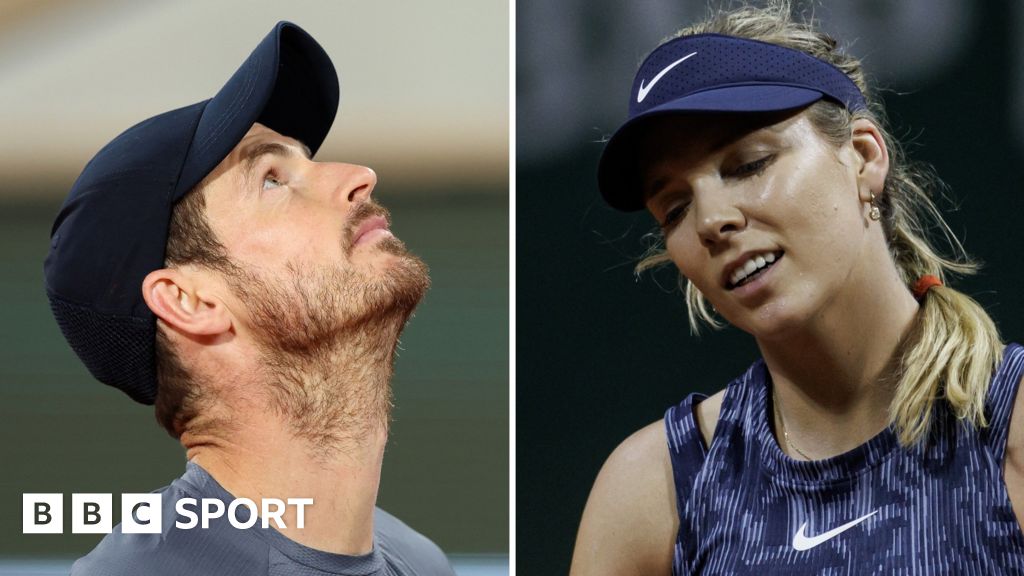Image source, Getty Images
- Author, Jonathan Jurejko
- Role, BBC Sport journalist at Roland Garros
For the third time this century, there has been a first-round wipeout of British singles players at the French Open.
Six Britons competed in the clay-court Grand Slam – Andy Murray, Katie Boulter, Cameron Norrie, Jack Draper, Dan Evans and Harriet Dart – and all lost their opening matches in the first three days.
That has led to some British fans demanding yet another inquest into why the nation cannot produce players who win regularly on the red dirt.
There has been pushback from the players, though. They point to improved performances over this European clay swing and tough draws across the board at Roland Garros.
“I think we’re actually in the best spot we’ve been in on clay for a long time,” said Evans.
“I think it’s not been a great tournament – it’s just how it’s panned out.”
How have Britons fared on clay?
Only one British player has won the French Open singles in the Open era – Sue Barker in 1976.
Since then, Murray reached the men’s final in 2016, while Johanna Konta went on a run to the women’s semi-finals in 2019.
This year, Britain had seven direct entrants into the main singles draws – the six who played and Jodie Burrage, who withdrew because of injury.
That was the highest number for Roland Garros since 1985.
“So much of playing on clay is confidence based. It’s about not buying into the hype of ‘Brits can’t play on clay’,” said former British player Naomi Broady.
“Yes, you might not have grown up on the surface and you might have to learn to develop that side of your game.
“But it doesn’t mean you can’t do it full stop. It’s not because you’re British that you’ll never be able to play well on it.”
Is there too much emphasis on British clay success?
Clay isn’t for everyone. The slower surface requires patience and it can be hard to trust your movement.
Japan’s Naomi Osaka once asked reporters to stop bringing up her lack of wins on clay because it was getting into her head.
Grass can be similar. It took Rafael Nadal time to grow more comfortable on the surface, while Norway’s Casper Ruud still says “grass is for golf”.
Britain’s Boulter had not played in the French Open main draw until this year – at the age of 27 and with a seeding of 26 – after previously being reluctant to compete on clay because of injury issues.
“It’s hard to decide whether to invest more time on the surface that you’re not comfortable on, and work out how your game fits on it,” added Broady.
“You’re constantly chasing ranking points in tennis, so are you going to chase them on a surface that isn’t your favourite or keep your season short and bypass it?
“It’s just changing that mentality and viewing the surface in a positive way which fits your game.”
Are players getting enough exposure to clay?
According to the Lawn Tennis Association, there are about 1,300 clay-courts in Great Britain. That is around 5% of the 23,000 total number of courts.
In contrast, about 60% of courts in Spain – one of the leading nations on the surface – are clay.
British Davis Cup captain Leon Smith told BBC Radio 5 Live that for clubs, the cost of maintaining a clay court is difficult – something not helped by the British weather.
The LTA’s National Tennis Centre has four Italian clay courts and the governing body is “forming new partnerships” with clay-court facilities in Barcelona and Girona, where young players can go for camps and training sessions.
Murray played in junior clay tournaments around Europe from the age of 12 and moved to Spain’s Sanchez-Casal Academy aged 15.
Fran Jones is another British player who went to the same academy.
“I do believe there is a slight reluctance for young British players to take a step out of the comfort zone,” Jones told BBC Sport.
“If the LTA can build a tolerance on clay for the juniors and feel they can step out of the comfort zone, I feel it would make things more smooth sailing.”

